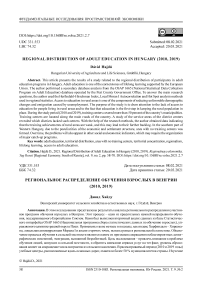Regional distribution of adult education in Hungary (2010, 2019)
Автор: Dávid Hajdú
Журнал: Региональная экономика. Юг России @re-volsu
Рубрика: Фундаментальные исследования пространственной экономики
Статья в выпуске: 2 т.9, 2021 года.
Бесплатный доступ
This article presents the results of a study related to the regional distribution of participants in adult education programs in Hungary. Adult education is one of the cornerstones of lifelong learning supported by the European Union. The author performed a secondary database analysis from the OSAP 1665 (National Statistical Data Collection Program on Adult Education) database operated by the Pest County Government Office. To answer the main research questions, the author used the Herfindahl-Hirschman Index, Local Moran I Autocorrelation and Hot Spot analysis methods used in regional statistics. Access to education in rural areas is one of the components of reducing unfavorable demographic changes and emigration caused by unemployment. The purpose of the study is to draw attention to the lack of access to education for people living in rural areas and to the fact that education is the first step in keeping the rural population in place. During the study period (2010 and 2019), training centers covered more than 50 percent of the country’s municipalities. Training centers are located along the main roads of the country. A study of the service areas of the district centers revealed which districts lacked such centers. With the help of the research methods, the author obtained data indicating that the training achievements of rural areas are weak, and this may lead to their further backlog. In the southern part of Western Hungary, due to the peculiarities of the economic and settlement structure, area with no training centers was formed. Over time, the problems will also appear in other social and economic indicators, which may require the organization of major catch-up programs
Adult education, territorial distribution, area with no training centers, territorial concentration, regionalism, lifelong learning, access to adult education
Короткий адрес: https://sciup.org/149135752
IDR: 149135752 | DOI: 10.15688/re.volsu.2021.2.7
Список литературы Regional distribution of adult education in Hungary (2010, 2019)
- 2013. évi LXXVII. törvény a felnőttképzésről. URL: https:// net.jogtar.hu/jogszabaly?docid=a1300077.tv.
- Anselin L., 1995. Local Indicators of Spatial Association. LISA Geographical Analysis, no. 27 (2), pp. 93-115.
- Benedek A., Csoma Gy., Harangi L., 2002. Felnőttoktatási és képzési lexicon A-Z. Budapest, Szaktudás Kiadó Ház. 568 p.
- Benedek A., Lőrincz É., 2016. Szakképzés és felnőttképzés: új rációk és emóciók a XXI. század elején. A felnőttképzésről három generáció nézőpontjából. Budapest, Magyarország, Magyar Pedagógiai Társaság, pp. 73-85.
- Egri Z., 2017. Magyarország városai közötti egészségegyenlőtlenségek. Területi Statisztika, no. 57 (5), pp. 537-575. DOI: 10.15196/TS570504.
- Európai Bizottság, 2000. Memorandum az egész életen át tartó tanulásról. Európai Közösségek Bizottsága, Brüsszel, október 30, 1832. 9 p.
- Farkas É., 2019. Adult Learning Is Key in the Adaptation to the Economic and Social Effects of the Fourth Industrial Revolution. Between Global and Local: Adult Learning and Communities Network: Learning and Living in Diverse Communities. University of Pécs, Hungary, pp. 18-27.
- Hajdú D., Koncz G., 2020. Álláskeresők támogatott felnőttképzésében résztvevők vizsgálata Borsod- Abaúj-Zemplén megyei helyszíneken. STUDIA MUNDI – ECONOMICA, vol. 7, no. 1, pp. 2-11. DOI: 10.18531/Studia.Mundi.2020.07.01.2-11.
- Heckman J.J., 2011. The American Family in Black & White: A Post-Racial Strategy for Improving Skills to Promote Equality. Dćdalus, the Journal of the American Academy of Arts & Sciences, vol. 140, no. 2, pp. 70-89.
- Heckman J.J., Masterov D.V., 2007. The Productivity Argument for Investing in Young Children. Review of Agricultural Economics, vol. 29, no. 3, pp. 446-493.
- Komarek L., 2012. A magyar ipar makroszintû specializációjának kérdései. PhD értekezés. Nyugatmagyarországi Egyetem Közgazdaságtudományi Kar Széchenyi István Gazdálkodás- és Szervezéstudományok Doktori Iskola, Sopron. 89 p.
- Koncz G., Szűcs A., 2017. A szolgáltató tevékenységek jelenléte és területi koncentrációja Heves megyében. LIX. Georgikon Napok: A múlt mérföldkövei és a jövő kihívásai: 220 éves a Georgikon. Keszthely, Magyarország, pp. 272-281.
- Koncz G., Szűcs A., Nagyné Demeter D., 2018. A gazdaság térszerkezetének változásai Észak-Magyarországon az ezredforduló után. Jelenkori Társadalmi és Gazdasági Folyamatok, no. 13 (1-2), pp. 139-149.
- Kozma T., 2000. Negyedik fokozat? INFOTársadalomtudomány, no. 49 (október), pp. 61-74.
- Lakner Sz., 2016. A felnőttképzési módszerek jelentősége és kihívásai az emberi erőforrás fejlesztési gyakorlatban. Pécs, Magyarország, Lartco Consulting Kft. 159 p.
- McMahon W.W., 2000. The Measurement of Externalities, Non-Market Effects, and Trends in the Returns to Education. The Appraisal of Investments in Educational Facilities. European Investment Bank/OECD. Paris, OECD.
- Polónyi I., 2019. Vigaszág vagy királyi. Educatio, no. 28 (4), pp. 767-782. DOI: 10.1556/2063.28.2019.4.8.
- Polónyi I., 2018. A felnőttképzés megtérülései. A felsőoktatási lifelong learning társadalmi és gazdasági haszna: kutatás – fejlesztés – innováció. Debrecen, Hungary. MELLearN Felsőoktatási Hálózat az életen át tartó tanulásért Egyesület, pp. 99-113.
- Schultz Th.W., 1983. Beruházások az emberi tőkébe. Budapest, Közgazdasági és Jogi Kiadó. 300 p.
- Tóth G., 2014. Térinformatika a gyakorlatban közgazdászoknak. Miskolci Egyetem, Miskolc. 107 p.
- Tóth J., 2017. Felnőttképzéssel a társadalmi kirekesztettség ellen? KÖZJAVAK, no. 3:3, pp. 21-26.
- Zachár L., 2003. Felnőttképzés, munkaerőpiaci képzés tervezése. Pécs, Magyarország: Pécsi Tudományegyetem Természettudományi Kar Felnőttképzési és Emberi Erőforrás Fejlesztési Intézet. 147 p.
- Zachár L. A felnőttképzés rendszere és főbb mutatói. URL: http://ofi.hu/felnottkepzes-rendszere-es-fobbmutatoi.
- OSAP 1665 Statisztikai Felület. Pest Megyei Kormányhivatal. URL: osap.mer.gov.hu.


